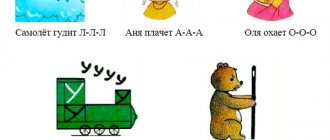10.07.2019
Sometimes even the cleanest owner of an apartment or house can have small black bugs in her cereals and flour. If measures are not taken to get rid of pests in a timely manner, they can become a serious problem. Let's look at how to permanently destroy uninvited guests.
- What types of bugs are found?
- Causes of insects in the kitchen
- Where do pests most often occur?
- How dangerous are cereals with bugs?
- 7 most effective pest control products
- Note to housewives
Write how a beetle buzzes
Young children often pronounce many sounds incorrectly.
If pronunciation defects do not disappear by the age of 4-5, it means that the child needs special exercises. In cases where sound pronunciation is impaired not due to hearing loss, parents can also work with the baby. It is very easy to check whether a child hears normally. You need to say a few sentences in a whisper at a distance of 6-7 meters from him, and if the baby can repeat them, then his hearing is fine. It is also important to determine whether the child correctly perceives sounds that are close in sound (“r” - “l”, “sch” - “s”, “l” - “l”). Invite him to find the difference in the meaning of words (bear-bowl, roof-rat, crayfish-lac, bow-hatch, goat-braid and others), ask him to show how a beetle buzzes (zh-zh), a mosquito squeaks (z- h-z), and say in which words a beetle lives and in which a mosquito lives: hedgehog, teeth, umbrella, acorns. While conducting these tests, you can play with your child - let him raise his hand or clap his hands, hearing the sound “sh”, “ch”, “r” in the proposed words: neck, fur coat, glasses, doctor, glad, row, rose, birch, hands. The child can come up with words with the given sound himself.
Correct pronunciation is sometimes hampered by a defective bite. In a normal bite, the upper teeth slightly overlap the lower teeth. To correct your bite, you need to see an orthodontist. Parents can easily determine whether the child’s tongue is mobile enough, whether he can make a large range of movements (up, down, forward - back, quickly click), whether the hyoid ligament, or, as it is also called, the frenulum, is well developed. If the frenulum is very short and the child cannot raise the tongue to the palate, we advise you to consult an otolaryngologist or speech therapist. The hypoglossal ligament plays an important role in pronouncing the sound “r”, as well as “sch”, “sh”, “zh”, “l”. There is no need to rush to trim it, as it is elastic and, if the child performs special exercises, it can stretch.
Here are a few such exercises:
1. Keep your wide tongue in the shape of a “cup” near the upper lip.
2. Move the tip of the tongue to the left and right corners of the lips.
3. Pull your lips into a tube and stretch them into a smile.
4. With your mouth open, use the tip of your tongue to stroke the palate in a forward-backward direction.
5. Slowly click your tongue, stretching the frenulum.
Let the child repeat each exercise 8-10 times 1-2 times a day.
Sometimes a child pronounces sounds incorrectly due to partial absence of teeth. But you don’t have to wait for your teeth to recover. If necessary, start practicing immediately.
Stick to a certain sequence. First, achieve the correct pronunciation of sounds, say, “s” and “r” or “sh” and “r”, “s” and “l”, that is, they are distant in formation and sound. Conduct classes in front of a mirror to control articulation.
Source of the article: https://logopeddoma.ru/publ/stati/v_kakikh_slovakh_zhuzhzhit_zhuk/2-1-0-10
Preview:
Consultation for parents:
“In what words does the BUG buzz?!”
Young children often pronounce many sounds incorrectly. If pronunciation defects do not disappear by the age of 4-5, it means that the child needs special exercises. In cases where sound pronunciation is impaired not due to hearing loss, parents can work with the child on their own. It is very easy to check whether a child hears normally. You need to say a few sentences in a whisper at a distance of 6-7 meters from him, and if the baby can repeat them, then his hearing is fine.
It is also important to determine whether the child correctly perceives by ear sounds similar in sound: “r” - “l”, “sh” - “s”, “l” - “l”. He should be asked to find the difference in the meaning of words (bear-bowl; roof-rat; crayfish-varnish; bow-hatch; goat-braid, etc.), ask him to show how a beetle buzzes (zh-zh), squeaks mosquito (z-z-z), and say in which words a beetle lives and in which a mosquito lives: hedgehog, teeth, umbrella, acorns. While conducting these tests, you can play with your child - let him raise his hand or clap his hands, hearing the sound “w”, “h”, “r” in the proposed words: neck, fur coat, glasses, doctor, glad, rose, birch, hands. The child can come up with words with the given sound himself.
Correct pronunciation is sometimes hampered by a defective bite. In a normal bite, the upper teeth slightly overlap the lower teeth. To correct your bite, you need to see an orthodontist. Parents can easily determine on their own whether the child’s tongue is mobile enough, whether he can make a large range of movements (up and down, back and forth, quickly click), whether the hyoid ligament, or as it is also called, the frenulum, is well developed. If the frenulum is very short and the child cannot raise the tongue to the palate, in such cases it is advised to consult an otolaryngologist. The hypoglossal ligament plays an important role in pronouncing the sound “r”, as well as “sch”, “sh”, “zh”, “l”. You should not rush to trim it, as it is elastic and, if the child performs special exercises, it can stretch.
∙ Hold your wide tongue in the shape of a “cup” at the upper lip.
∙ Move the tip of the tongue to the left and right corners of the lips alternately.
∙ Pull your lips into a tube and stretch them into a smile.
∙ With your mouth open, use the tip of your tongue to stroke the palate back and forth.
∙ Slowly flick your tongue, stretching the frenulum.
Let the child perform each exercise 5-10 times once or twice a day, this will be enough.
Sometimes a child pronounces sounds incorrectly due to partial absence of teeth. But there is no need to wait for the dentition to be restored. If necessary, start practicing immediately.
Stick to a certain sequence. First, achieve the correct pronunciation of sounds, he will say, “s” and “r” or “sh” and “r”, “s” and “l”, that is, distant in formation and sound. Classes should be carried out in front of a mirror to control the correct articulation.
When pronouncing the sound “C”, the front edge of the tongue rests on the lower teeth, a stream of air is exhaled without a voice, and when pronouncing the sound “Z” with a voice (to control, you need to put your hand on the larynx to feel its tension). If a child's tongue sticks out between the teeth, then its front part should be held behind the lower teeth with the handle of a teaspoon. You can also ask the child to pronounce the sound with clenched teeth, while the tongue rests on the base of the lower teeth. Gradually, the teeth can be slightly moved apart.
If the child pronounces the sounds “S” and “Z” as soft hissing sounds (sledges - shanks, teeth - juby), then you should ask him to bite the front edge of his tongue, and then unclench his teeth without changing its position, and exhale, accompanying the exhalation with sound. After several lessons, when the tongue easily takes the required position, let the child move the tip of the tongue behind the teeth. If he pronounces the sound in an isolated version easily, without difficulty, then it’s time to move on to practicing it in syllables, first direct (sa, so, su, for, zo, zu), then reverse (as, os, us, az, oz, uz) in the position between vowels (asa, oso, usu, aza, ozo, uzu), in words at the beginning of a word (garden, falcon, sleep), at the end of a word (kvass, nose, taste), in the middle of a word (pause, sock, scales). Speech material can be poems, songs, fairy tales, stories. It should be selected so that this material is equipped with a sound, the pronunciation of which the child masters.
When setting soft “C” and “Z”, the tongue is more tense, its front edge rests forcefully against the base of the lower teeth. Having mastered the sound “S”, it is easy to learn “C” if you pronounce “T – S” quickly and smoothly. The sound “Ts” is fixed first in reverse syllables (ats, ots, uts), and then in straight syllables (tsa, tso, tsu).
The first method: pronouncing the sound “Ш”: raise the front edge of the tongue in the form of a cup to the front of the hard palate, forming a gap, and blow on the tip of the tongue.
The second way: pronounce “S” while simultaneously lifting your tongue by the upper teeth with the handle of a teaspoon. Lightly squeeze the child's cheeks with your fingers and ask his lips to stretch forward in the form of a mouthpiece.
The sound “Zh” is pronounced without the participation of the voice: instead of “Sh” you can pronounce the sound “Z”. If you ask a child to repeat “TH” several times, while moving the tip of the tongue away from the upper teeth into the back of the mouth, the sound “CH” will be produced. The lips should be slightly forward. The sound is fixed starting with reverse syllables (ach, och, ich).
The sound “Sh” is formed if you invite the child to pronounce a soft “Sh” (sh, sh, sh) for a long time or, “Sh”, move the tongue forward to the upper teeth.
The hard sounds “L” and “R” are the most difficult: the child begins to pronounce these sounds correctly sometimes by the age of 6 or even later. But exercises should begin at 4-5 years old.
Often the child pronounces the sound “L” distorted (lamp - yampa, lyampa, wampa, rampa, yampa). The correct position of the speech organs is as follows: lips and teeth are open, the tip of the tongue rests on the upper teeth, exhaled air passes through the free lateral passages.
The simplest exercises for training to pronounce the sound “L”:
1. Open your mouth wide, pronounce “A” for a long time and gradually close your mouth. When you bite your tongue, you will hear an “L” sound.
2. Bite the wide tip of the tongue with your teeth, “hum” and, without changing the position of the tongue, pronounce “A” or “Y”. If you speed up the tempo, you get - la - la - la, ly - ly - ly.
3. From the position between the teeth, gradually move the tongue behind the upper teeth.
4. Pronounce “Y” and raise your tongue to your upper teeth.
5. When pronouncing the sound “L” with your lips, slow down the forward movement of your lips, holding them with your fingers in a smile mask. Then carry out 1, 2, 3.
When pronouncing “L” correctly, the tongue is tense, the tip of the tongue rests forcefully against the base of the upper teeth.
There are many options for defective pronunciation of the sound “R” (side, throat, burr, labial). With the correct position of the speech organs, the lips and teeth are open, the cup-shaped tongue is raised to the alveoli (tubercles behind the upper teeth; when in contact with them, the tongue vibrates under the pressure of a strong stream of exhaled air).
The most accessible methods for making the sound “R” for independent work are as follows:
1. Lightly press the tip of your tongue with the handle of a teaspoon and pronounce “f – f – f” for a long time.
2. As you exhale, quickly pronounce the sound “t - t - t” and end with a push-exhalation - “TRRR”.
3. Using your first and index fingers, press the lateral edges of the tongue to the palate, leaving the middle of the tongue free. Have the child take a deep breath and blow out the air while using his voice. Repeating the exercise, you need to increase the air pressure, as a result of which you hear “TRRR”.
The soft sound “Рь” is pronounced with some movement of the tongue forward and upward and pressing the lateral edges of the tongue to the lateral teeth.
To achieve positive results, you should exercise at least 2 times daily for 15 to 20 minutes.
Remember that when talking to a child, you cannot copy his defective pronunciation. Be attentive to yourself: the child imitates adults and can adopt the carelessness, haste, and unclearness of your speech
Source of the article: https://nsportal.ru/detskiy-sad/logopediya/2014/05/11/naydi-v-kakikh-slovakh-zhuzhzhit-zhuk
How dangerous are cereals with bugs?
Eating contaminated cereals or flour containing bugs is unacceptable. However, after the products are processed, this is quite possible, but of course it is hardly pleasant. It is important to understand here that while sorting or sifting cereals, it is still impossible to completely get rid of the larvae, as well as traces of the vital activity of these pests.
In small quantities, this does not pose a threat to healthy adults. However, for children and weakened people there is a risk of intoxication, accompanied by stomach upset, vomiting and fever.
In the absence of medical problems and ignoring the psychological factor, it is possible to consume contaminated products if they are first processed - heating or freezing.
Bugs in the cereal
Almost all of these insects with larvae die in temperatures below -15 and above +50. How to achieve this:
- To freeze a bag of cereal, you need to put it in the freezer for a day. In winter, you can take food outside or onto the balcony, but you need to take into account that the temperature should not exceed -15.
- To heat, you need to pour the cereal onto a baking sheet, spread it over the surface, and put it in the oven for 30 minutes, heated to +200.
- After freezing or heating, flour can be sifted through a fine sieve, which will retain the insects themselves, larvae, and eggs. Once these steps are complete, the flour can be safely used.









